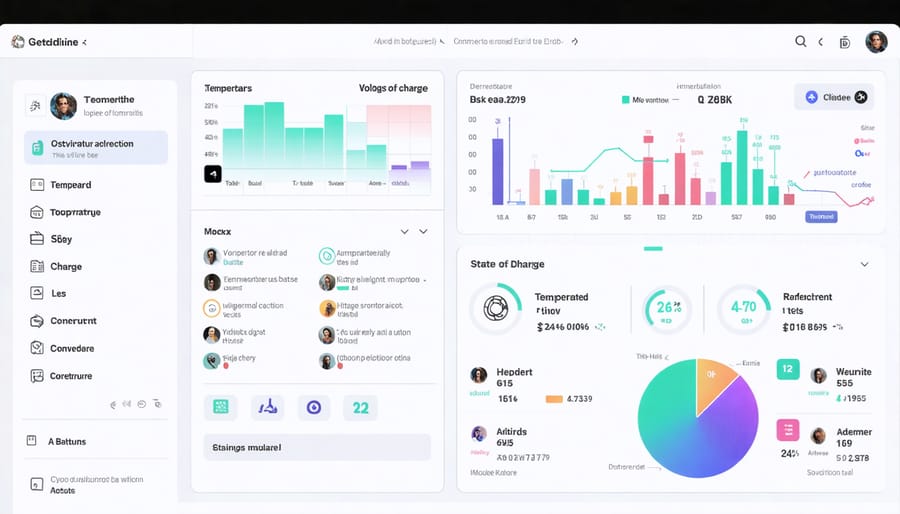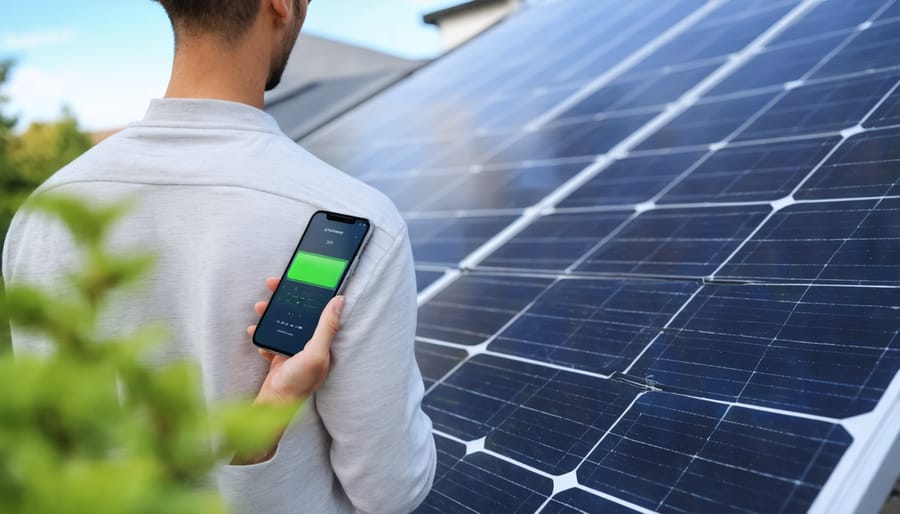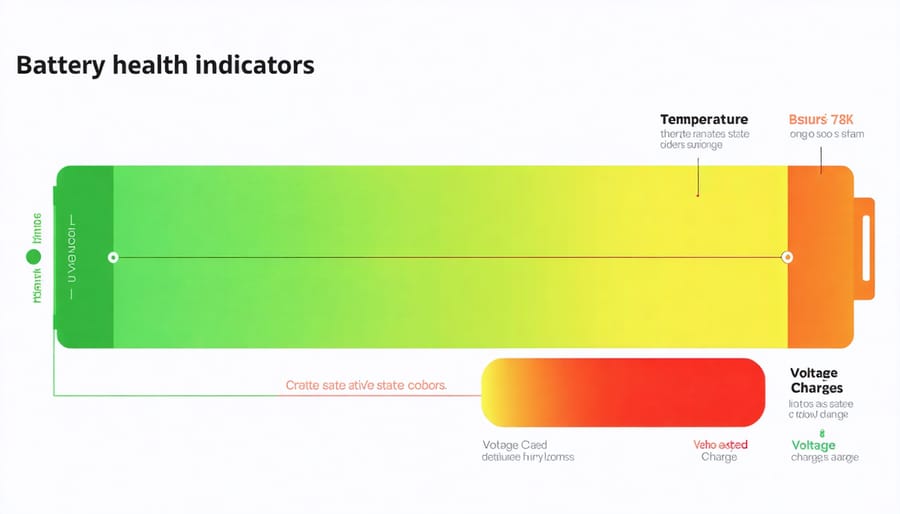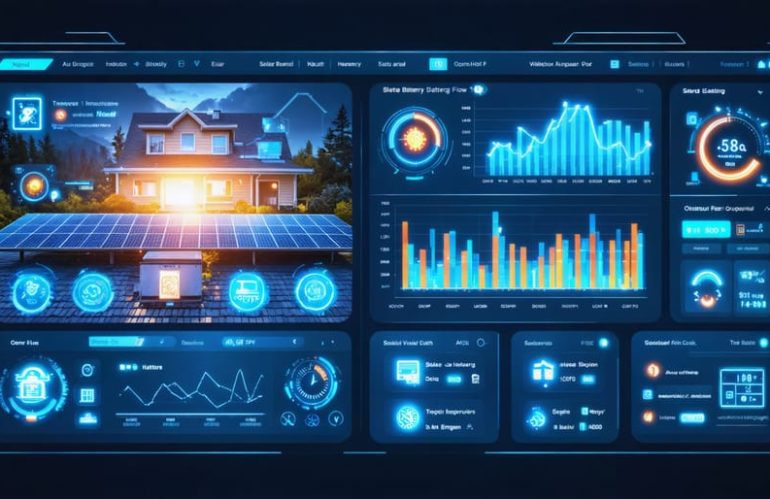Protect and optimize your solar investment with advanced battery monitoring systems that transform raw data into actionable insights. As residential solar systems become increasingly sophisticated, real-time battery monitoring has emerged as the cornerstone of efficient energy management. Modern monitoring solutions track battery health, charging cycles, and power flow, enabling homeowners to maximize storage capacity and extend battery life. By providing instant alerts, performance analytics, and consumption patterns, these smart systems help you make informed decisions about your energy usage while ensuring your solar battery operates at peak efficiency. Whether you’re looking to reduce utility bills or achieve energy independence, understanding your battery’s performance through sophisticated monitoring is the key to unlocking the full potential of your solar investment.
Why Your Solar Battery System Needs Active Monitoring
Protecting Your Investment
A solar battery monitoring system serves as your investment’s guardian, continuously watching over your battery’s health and performance. By tracking crucial parameters like charge levels, temperature, and usage patterns, the system prevents common issues that could lead to expensive repairs or replacements. Think of it as a health monitor for your battery, alerting you before small problems become major concerns.
Regular monitoring helps maintain optimal charging cycles, prevents excessive discharge, and ensures your battery operates within safe temperature ranges. This proactive approach can extend your battery’s lifespan by up to 50% compared to unmonitored systems. The system also protects against common issues like overcharging and deep discharge, which are primary causes of premature battery failure.
For most homeowners, a quality monitoring system can help protect their investment for years to come, potentially saving thousands in replacement costs while ensuring consistent performance from their solar energy system.
Optimizing Energy Usage
A solar battery monitoring system plays a crucial role in helping homeowners maximize energy efficiency through intelligent energy management. By tracking real-time battery performance, the system helps you understand when to store excess solar power and when to use it, ensuring optimal usage of your stored energy.
The monitoring system provides valuable insights into your daily energy consumption patterns, allowing you to make informed decisions about when to run high-energy appliances. For instance, you can schedule energy-intensive tasks during peak solar production hours or when your batteries are fully charged.
Additionally, the system helps extend battery life by preventing over-charging and excessive discharge. It automatically adjusts charging patterns based on weather forecasts and your household’s energy needs, ensuring you always have power when you need it most. This smart management not only reduces your reliance on grid power but also helps lower your monthly energy bills while maintaining optimal battery performance.

Key Components of a Battery Monitoring System
Voltage and Current Sensors
Voltage and current sensors are the eyes and ears of your solar battery monitoring system. These small but essential devices keep track of how much power is flowing in and out of your batteries at any given time. The voltage sensor measures the electrical pressure in your battery system, helping you understand how full or empty your batteries are – think of it like a fuel gauge for your energy storage. Current sensors, on the other hand, track the flow of electricity, showing you whether your batteries are charging or discharging and at what rate. Together, these sensors provide real-time data that helps protect your investment by preventing overcharging and ensuring your batteries operate within safe limits. Most modern systems include built-in sensors that communicate directly with your monitoring display or smartphone app, making it easy to keep an eye on your battery’s health.
Temperature Monitoring
Temperature plays a crucial role in your solar battery’s performance and longevity. Think of your battery like a sensitive plant – it thrives best within specific temperature ranges. Most solar batteries perform optimally between 68°F and 77°F (20-25°C). When temperatures rise above or fall below this range, your battery’s efficiency can drop, and its lifespan might decrease.
A good monitoring system keeps track of your battery’s temperature in real-time, alerting you before issues arise. This proactive approach helps prevent damage from overheating or freezing, which could lead to costly repairs or replacements. The system can automatically adjust charging rates or even temporarily disconnect the battery if temperatures become unsafe.
By maintaining ideal temperature conditions, you’re not just protecting your investment – you’re ensuring consistent power supply and maximum energy savings throughout the year.
State of Charge Tracking
State of Charge (SoC) tracking is like having a fuel gauge for your solar battery system. It shows you exactly how much energy is available at any given time, typically displayed as a percentage from 0% to 100%. By monitoring these levels, you can better understand your household’s energy consumption patterns and make smarter decisions about when to use stored power versus grid electricity.
Modern monitoring systems provide real-time updates and historical data, helping you identify peak usage times and adjust your habits accordingly. For example, you might discover that running your dishwasher during solar production hours, rather than in the evening, helps maintain higher battery levels for nighttime use.
This tracking feature also helps prevent over-discharge, which can damage your batteries, while ensuring you have enough stored energy for emergencies or high-demand periods.
Real-Time Monitoring Features That Matter
Mobile App Integration
Modern solar battery monitoring systems put complete control at your fingertips through user-friendly mobile apps. These apps transform your smartphone into a powerful monitoring station, allowing you to track your system’s performance from anywhere with an internet connection. As part of smart solar integration, these apps provide real-time updates on battery charge levels, energy production, and consumption patterns.
Most monitoring apps offer intuitive dashboards that display essential information like current power flow, battery status, and savings achieved. You’ll receive instant notifications about system performance, potential issues, or maintenance needs. This immediate awareness helps you optimize energy usage and respond quickly to any concerns.
The apps typically include features like historical data analysis, energy consumption forecasts, and customizable alerts. You can easily switch between different viewing modes, from simple overviews to detailed performance metrics. Some apps even provide energy-saving tips based on your usage patterns and weather forecasts, helping you maximize your system’s efficiency and reduce electricity bills further.
For added convenience, many apps allow you to control system settings remotely, such as adjusting power flow priorities or scheduling battery charging during off-peak hours.

Alert Systems
Modern solar battery monitoring systems come equipped with sophisticated alert features that keep you informed about your system’s health and performance. These automated notifications act like a vigilant guardian, instantly alerting you when something requires attention. You’ll receive real-time notifications through your smartphone app or email about critical events such as low battery levels, unusual power consumption patterns, or potential system issues.
The alert system typically includes customizable thresholds, allowing you to set specific parameters that match your energy needs and preferences. For instance, you can set alerts for when your battery charge drops below 20% or when your solar production falls below expected levels. Some systems even predict potential problems before they occur, using smart algorithms to analyze performance patterns.
These notifications aren’t just about problems – they also celebrate positive milestones, like achieving peak efficiency or reaching energy saving goals. Many systems provide weekly or monthly performance summaries, helping you track your progress toward energy independence. This proactive approach to system monitoring ensures you’re always in control of your solar investment while maintaining peace of mind.
Making Sense of Your Battery Data

Common Readings Explained
When monitoring your solar battery system, you’ll encounter several key readings that indicate your battery’s health and performance. The most important is the State of Charge (SOC), displayed as a percentage showing how full your battery is – similar to a fuel gauge in your car. Voltage readings tell you the electrical potential of your battery, typically ranging from 12 to 48 volts for home systems. Current flow, measured in amperes (amps), shows how much electricity is moving in or out of your battery.
Temperature readings are crucial too, as batteries perform best between 68-77°F (20-25°C). The Depth of Discharge (DOD) indicates how much of your battery’s capacity you’re using, while cycle count tracks how many times your battery has been charged and discharged. Understanding these basic metrics helps you maintain optimal battery performance and extend its lifespan, ensuring you get the most value from your solar investment.
When to Take Action
Regular monitoring of your solar battery system can help you spot warning signs early. Take immediate action if you notice sudden drops in battery performance, unusual charging patterns, or if your monitoring system shows consistent undervoltage or overvoltage alerts. When your battery’s charging efficiency falls below 85%, it’s time to consult a professional for a thorough inspection.
Pay attention to temperature readings – if they frequently exceed recommended ranges or show irregular fluctuations, this could indicate ventilation issues or internal problems. Watch for error messages about connection failures or data inconsistencies, as these might signal communication problems between components.
Schedule maintenance when your monitoring system shows declining charge cycles, or if the battery takes significantly longer to reach full charge. Also, consider professional evaluation if you notice your energy storage capacity decreasing by more than 20% from its original specifications. Regular system checks every 3-6 months can help prevent major issues and extend your battery’s lifespan.
A solar battery monitoring system is more than just a technological addition to your solar setup – it’s your key to maximizing your renewable energy investment. By implementing proper monitoring, you can extend your battery’s lifespan, optimize energy usage, and potentially save thousands of dollars in replacement costs over time. The peace of mind that comes from knowing your system is performing optimally and being alerted to any issues before they become serious problems is invaluable.
Taking the next step toward implementation is straightforward. Start by assessing your current setup and determining which monitoring features would benefit you most. Consider consulting with a solar professional who can recommend a system that matches your specific needs and budget. Remember to look for user-friendly interfaces and mobile connectivity options that will make daily monitoring effortless.
As solar technology continues to evolve, battery monitoring systems will become even more sophisticated and accessible. By embracing these tools today, you’re not just protecting your investment – you’re taking an active role in the sustainable energy revolution while ensuring your home remains powered efficiently for years to come.








